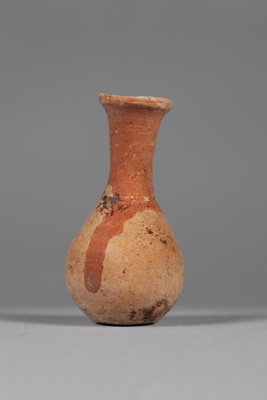< Collection search
< Collection highlights
From:UC Teece Museum of Classical Antiquities
Name/TitleFlask
About this objectMiniature flasks like this were probably used almost exclusively for perfumes. The narrow necks with rounded bodies were ideal for the fragrant oils and could be stoppered with cork or wood fragments. This vase has been made of fine orange-brown clay and has a slightly flattened base. The upper part has been dipped in a red-firing slip which has dribbled down one of the sides before firing.
Perfumes were an important part of daily life for ancient cultures. As far back as the Bronze Age (four to five thousand years ago), perfumes were manufactured and exported around the Mediterranean. They were used for spiritual and religious ceremonies and for personal hygiene. It was also thought that perfumes had healing properties, and Hippocrates (the 'father of medicine') prescribed fumigation and perfumes to ward off illness. Both the Greeks and the Romans were devotees of public baths, and after exercise and bathing would often be massaged with scented oils before heading off to their next engagement. Given that soap was unknown at this point, the various fragrances could hide a multitude of sins of personal hygiene.
Date Madeca. 1st century CE
PeriodEarly Imperial
Medium and MaterialsCeramic: Pottery
Style and IconographyHellenistic
Style and IconographyRoman
TechniqueThrowing (pottery technique)
TechniqueGlazing (coating process)
MeasurementsHeight 82mm; Diameter 32mm
Subject and Association KeywordsCosmetics
Subject and Association KeywordsPersonal beauty
Named CollectionThe James Logie Memorial Collection, University of Canterbury, New Zealand
Credit LineDonated by Mrs Broadhead, 1968. From the collection of Professor H.D. Broadhead.
Object TypeStorage Vessels
Object number82.68
Copyright LicenceAll rights reserved
